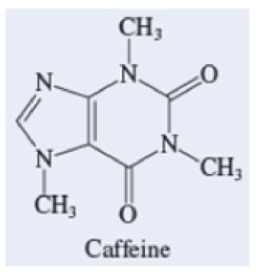
Concept explainers
Caffeine, the stimulant in coffee and tea, is a weak base that ionizes in water according to the equation

A 0.15-M solution of caffeine at 25°C has a pH of 8.45. Determine the Kb of caffeine.
Interpretation:
The
Concept Information:
Base ionization constant:
The ionization of a weak base
The equilibrium expression for the ionization of weak base
Where,
pOH definition:
The
Relationship between pH and pOH
The relationship between the hydronium ion concentration and the hydroxide ion concentration is given by the equation,
As
To Calculate: The
Answer to Problem 16.15WE
Answer
The
Explanation of Solution
Given data:
Caffeine is the stimulant in tea and coffee.
Caffeine is a weak base which ionizes in water as follows,
The pH of the given 0.15 M solution of caffeine is 8.45
Calculation strategy:
Using the given pH, the pOH can be found, then from pOH obtained, the hydroxide ion concentration is calculated.
From the obtained hydroxide ion concentration, use reaction stoichiometry to determine the other equilibrium concentrations, then evaluate
Calculation of pOH:
The pOH can be calculated using the following formula as follows,
Therefore, the pOH of the given caffeine solution is 5.55
Calculation of hydroxide ion:
The hydroxide ion can be calculated as follows,
Therefore, the concentration of
Calculation of
The concentration of hydroxide ion for the given weak base can be found out from its equilibrium reaction with water.
Based on the stoichiometry,
If the concentration of
We summarize the changes as follows,
|
| |||
|
Initial
|
0.15
|
|
|
|
Change
|
|
| |
|
Equilibrium
|
|
| |
Therefore, the base ionization constant
The
Want to see more full solutions like this?
Chapter 16 Solutions
Chemistry: Atoms First
- Using the diagrams shown in Problem 10-37, which of the four acids is the weakest acid?arrow_forwardCalculate [OH-] and pH in a solution in which the hydrogen sulfite ion, HSO3-, is 0.429 M and the sulfite ion is (a) 0.0249 M (b) 0.247 M (c) 0.504 M (d) 0.811 M (e) 1.223 Marrow_forwardIn each of the following acid-base reactions, identify the Brnsted acid and base on the left and their conjugate partners on the right. (a) HCO2H(aq) + H2O() HCO2(aq) + H3O+(aq) (b) NH3(aq) + H2S(aq) NH4+(aq) + HS(aq) (c) HSO4(aq) + OH(aq) SO42(aq) + H2O+()arrow_forward
- Which of the terms weak, strong, monoprotic, diprotic, and triprotic characterize(s) each of the following acids? More than one term may apply in a given situation. a. H3PO4 b. H3PO3 c. HBr d. HC2H3O2arrow_forwardWrite the reaction and the corresponding Kb equilibrium expression for each of the following substances acting as bases in water. a. NH3 b. C5H5Narrow_forwardTo measure the relative strengths of bases stronger than OH, it is necessary to choose a solvent that is a weaker acid than water. One such solvent is liquid ammonia. (a) Write a chemical equation for the autoionization of ammonia. (b) What is the strongest acid and base that can exist in liquid ammonia? (c) Will a solution of HCI in liquid ammonia be a strong electrical conductor, a weak conductor, or a nonconductor? (d) Oxide ion (O2) is a stronger base than the amide ion (NH2). Write an equation for the reaction of O2 with NH3 in liquid ammonia. Will the equilibrium favor products or reactants?arrow_forward
- In each of the following acid-base reactions, identify the Brnsted acid and base on the left and their conjugate partners on the right. (a) C2H5N(aq) + CH3CO2H(aq) C5H5NH+(aq) + CH3CO2(aq) (b) N2H4(aq) + HSO4(aq) N2H5+(aq) + SO42(aq) (c) [Al(H2O)6]3+ (aq) + OH(aq) [Al(H2O)5OH]2+ (aq) + H2O+()arrow_forwardEthanol (ethyl alcohol), CH3CH2OH, can act as a BrnstedLowry acid. Write the chemical equation for the reaction of ethanol as an acid with hydroxide ion, OH. Ethanol can also react as a BrnstedLowry base. Write the chemical equation for the reaction of ethanol as a base with hydronium ion, H3O+. Explain how you arrived at these chemical equations. Both of these reactions can also be considered Lewis acid base reactions. Explain this.arrow_forwardThe active ingredient formed by aspirin in the body is salicylic acid, C6H4OH(CO2H). The carboxyl group. (-CO2H) acts as a weak acid. The phenol group (an OH group bonded to an aromatic ring) also acts as an acid but a much weaker acid. List, in order of descending concentration, all of the ionic and molecular species present in a 0.001-M aqueous solution of C6H4OH(CO2H).arrow_forward
 Chemistry & Chemical ReactivityChemistryISBN:9781337399074Author:John C. Kotz, Paul M. Treichel, John Townsend, David TreichelPublisher:Cengage Learning
Chemistry & Chemical ReactivityChemistryISBN:9781337399074Author:John C. Kotz, Paul M. Treichel, John Townsend, David TreichelPublisher:Cengage Learning Chemistry & Chemical ReactivityChemistryISBN:9781133949640Author:John C. Kotz, Paul M. Treichel, John Townsend, David TreichelPublisher:Cengage Learning
Chemistry & Chemical ReactivityChemistryISBN:9781133949640Author:John C. Kotz, Paul M. Treichel, John Townsend, David TreichelPublisher:Cengage Learning Chemistry: The Molecular ScienceChemistryISBN:9781285199047Author:John W. Moore, Conrad L. StanitskiPublisher:Cengage Learning
Chemistry: The Molecular ScienceChemistryISBN:9781285199047Author:John W. Moore, Conrad L. StanitskiPublisher:Cengage Learning Chemistry: Principles and PracticeChemistryISBN:9780534420123Author:Daniel L. Reger, Scott R. Goode, David W. Ball, Edward MercerPublisher:Cengage Learning
Chemistry: Principles and PracticeChemistryISBN:9780534420123Author:Daniel L. Reger, Scott R. Goode, David W. Ball, Edward MercerPublisher:Cengage Learning General, Organic, and Biological ChemistryChemistryISBN:9781285853918Author:H. Stephen StokerPublisher:Cengage Learning
General, Organic, and Biological ChemistryChemistryISBN:9781285853918Author:H. Stephen StokerPublisher:Cengage Learning Chemistry: An Atoms First ApproachChemistryISBN:9781305079243Author:Steven S. Zumdahl, Susan A. ZumdahlPublisher:Cengage Learning
Chemistry: An Atoms First ApproachChemistryISBN:9781305079243Author:Steven S. Zumdahl, Susan A. ZumdahlPublisher:Cengage Learning





